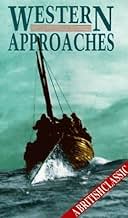Gripping wartime re-enactment of perils at sea by the very people who experienced the harrowing events here depicted (with one or two exceptions), this is an engrossing movie with some of the finest color photography of the decade. Jackson's direction of his non-professional cast is so immaculately adept, it's hard to believe that these are real people on the screen, re-living real events, not actors going through their paces in a script carefully honed for the utmost drama and suspense. True, real events have been telescoped, but, if anything, the terrors we see on the screen have been diluted, rather than magnified. In fact, the whole movie is a tribute not only to the men of the Royal Navy, but to the skill of the film-makers.
This was writer-director Pat Jackson's first feature film, yet oddly he was not able to capitalize on his sudden fame. Metro-Goldwyn-Mayer put him under contract, but kept him hanging around doing nothing (and getting paid for it) until handing him a routine "B" assignment starring Ann Sothern and Zachary Scott, Shadow on the Wall, to direct in 1950.
Returning to England, Jackson directed White Corridors and one of the Somerset Maugham stories in Encore in 1951. A disappointing Anthony Steel vehicle, intended as an "A" feature but understandably released as a "B", Something Money Can't Buy, followed in 1952. Jackson then remained idle until 1956 when he directed a routine Belinda Lee vehicle, The Feminine Touch, which even made the lovely Belinda seem dull and uninspired. A boring hero (George Baker) didn't help either; while a similarly lack-luster cast (Tony Britton, Sylvia Sims, Jack Watling) and script undermined The Birthday Present (1957). Jackson was fast earning a reputation as a routine hack, but managed to redeem himself with Virgin Island (1959) in which he had the services of a fine group of players headed by Sidney Poitier, John Cassavettes, Virgina Maskell. Although the movie achieved great notices, it failed to recoup its modest negative cost.
My guess is that at this point Jackson lost interest – and no wonder! He found work directing two "B" features, Snowball (1960) and Seven Keys (1961). His remaining six films, with the exception of What a Carve Up! which successfully attempted to cash in on the popularity of the Carry On movies – in fact many critics (including me) headlined our reviews, Carry On Carving – were likewise disappointments. In 1964 and 1968, he even directed and wrote quota quickies, Seventy Deadly Pills and On the Run, respectively, for the Children's Film Foundation. So that makes On the Run actually his last movie. King Arthur, the Young Warlord (1975) is a TV cut-down – as was To Chase a Million (1967).
P.S. I've omitted Don't Talk to Strange Men (1962) from this line-up. It was banned in 1962 and I've never seen it, although reportedly it is an effective (if very small-scale) thriller.



















